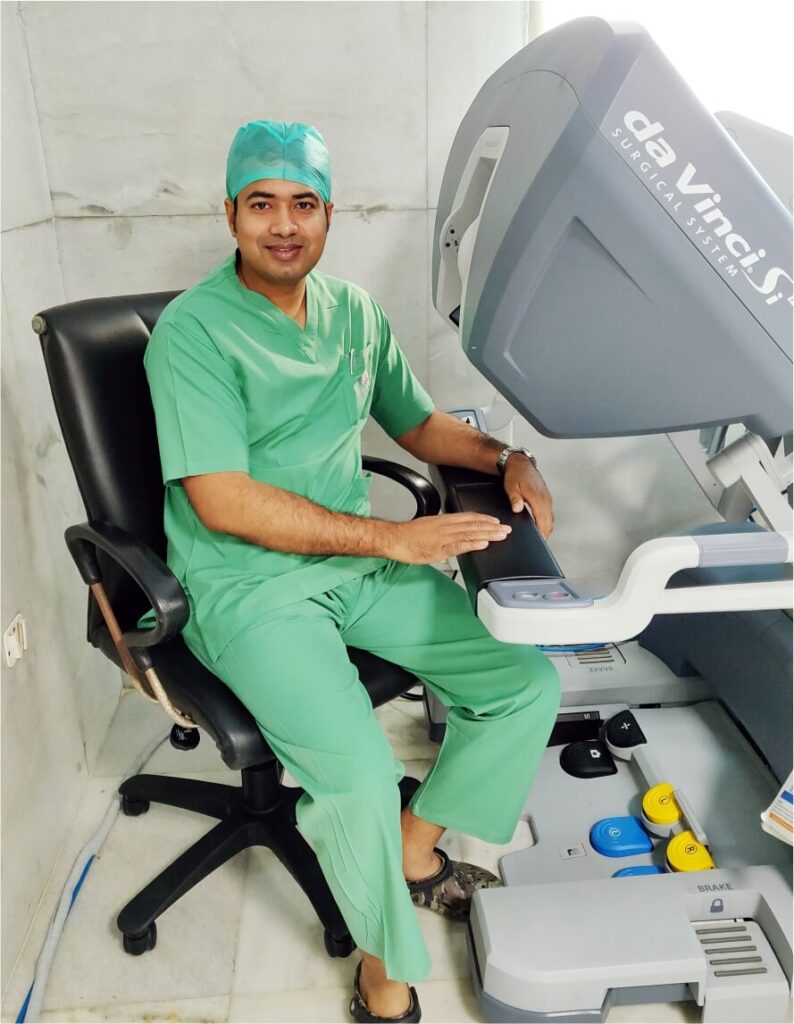
What is Robotic Surgery?
Robotic surgery, also known as robot-assisted surgery, is an advanced technique utilized by expert urologists to improve the precision and outcomes of complex surgical procedures. This technology allows surgeons to access hard-to-reach areas of the body through small incisions, enhancing the accuracy of the operation. The robotic system also offers surgeons highly refined control and magnified visualization during surgery. The key components of robotic technology include:
Surgical Arms: Equipped with small instruments and flexible wrists, these arms provide 7 degrees of movement, offering superior dexterity during the procedure.
Specialized Lenses: These provide a magnified, high-definition 3D view of the surgical field, allowing for greater detail and precision.
Surgical Console: This is the control center where the surgeon directs the robotic arms and camera, ensuring precise movements and enhanced control throughout the procedure.
Robotic Surgery in Urology
Over the past decade, robotic surgery has witnessed remarkable advancements, and its applications in the field of urology have expanded significantly. Urology is now at the forefront of robotic-assisted surgery, particularly due to the need for precision in procedures involving the pelvic area.
The pelvic region is densely packed with vital blood vessels and organs, making accuracy crucial during surgery. Robotic surgery offers several benefits over traditional open or laparoscopic methods, such as:
- Reduced Blood Loss: The precision of robotic surgery minimizes bleeding during the procedure.
- Less Post-Operative Pain: Patients experience less discomfort, leading to a reduced need for pain medications.
- Shorter Hospital Stay: Faster recovery times allow patients to go home sooner.
- Quicker Healing: Smaller incisions and more refined techniques result in quicker recovery times for patients.
Dr. Venkatesh Kumar, a leading urologist and robotic surgeon, employs this cutting-edge technology to provide exceptional care and improved surgical outcomes for his patients.
Myth 1: Robotic Surgery is Performed Entirely by Robots
Reality: One of the most common misconceptions is that robots independently perform surgery. In reality, robotic surgery is a highly controlled procedure where the surgeon operates the robotic system. The robotic arms replicate the surgeon’s hand movements with higher precision, providing enhanced control during the procedure.Myth 2: Robotic Surgery is Only Suitable for Complex Cases
Reality: While robotic surgery is often associated with complex procedures, it is suitable for a wide range of urological surgeries, including prostatectomy, kidney surgeries, and bladder surgeries. The enhanced precision of robotic systems is beneficial for both complex and routine surgeries, improving recovery time and reducing complications.Myth 3: Robotic Surgery Has a Higher Risk of Complications
Reality: Robotic surgery in urology is known for its precision, resulting in fewer complications. The smaller incisions lead to reduced blood loss, minimal scarring, and faster recovery times. Studies have shown that robotic surgery often results in better patient outcomes when compared to traditional open surgery.Myth 4: Robotic Surgery is Extremely Expensive
Reality: While robotic surgery may have a higher upfront cost due to the advanced technology, the overall costs can be comparable to traditional surgery. Shorter hospital stays, reduced post-operative care, and faster recovery time often offset the higher initial costs, making robotic surgery a cost-effective option in many cases.Myth 5: Robotic Surgery is New and Unproven
Reality: Robotic surgery in urology has been practiced for over two decades and is well-established in the medical community. It has a proven track record of success in thousands of surgeries worldwide, particularly in prostate, kidney, and bladder procedures.Benefits of Robotic Surgery in Urology
Robotic-assisted surgery offers a range of benefits, especially in urology, where precision is crucial. These include:
- Minimally Invasive: Smaller incisions lead to less post-operative pain and quicker recovery times.
- Enhanced Precision: Robotic arms eliminate hand tremors, providing more accuracy during delicate surgeries.
- Reduced Blood Loss: The precision of robotic surgery often results in less blood loss during operations.
- Shorter Hospital Stay: Patients typically experience faster recovery, reducing hospital stay durations.
- Better Visuals for Surgeons: The 3D high-definition view provided by robotic systems allows for a clearer and magnified view of the surgical area.
Common Procedures in Robotic Urology
Some of the common robotic surgeries performed by Dr. Venkatesh Kumar include:- Robotic Prostatectomy: Removal of the prostate gland, often for prostate cancer treatment.
- Robotic Nephrectomy: Removal of kidney tumors or the entire kidney.
- Robotic Pyeloplasty: Correcting blockages or narrowing in the kidney.
- Robotic Bladder Surgery: Treatment of bladder cancer or reconstruction of the bladder.
- Other procedures: These include Nephroureterectomy, Adrenalectomy, Ureteric reimplantation, Kidney transplantation

